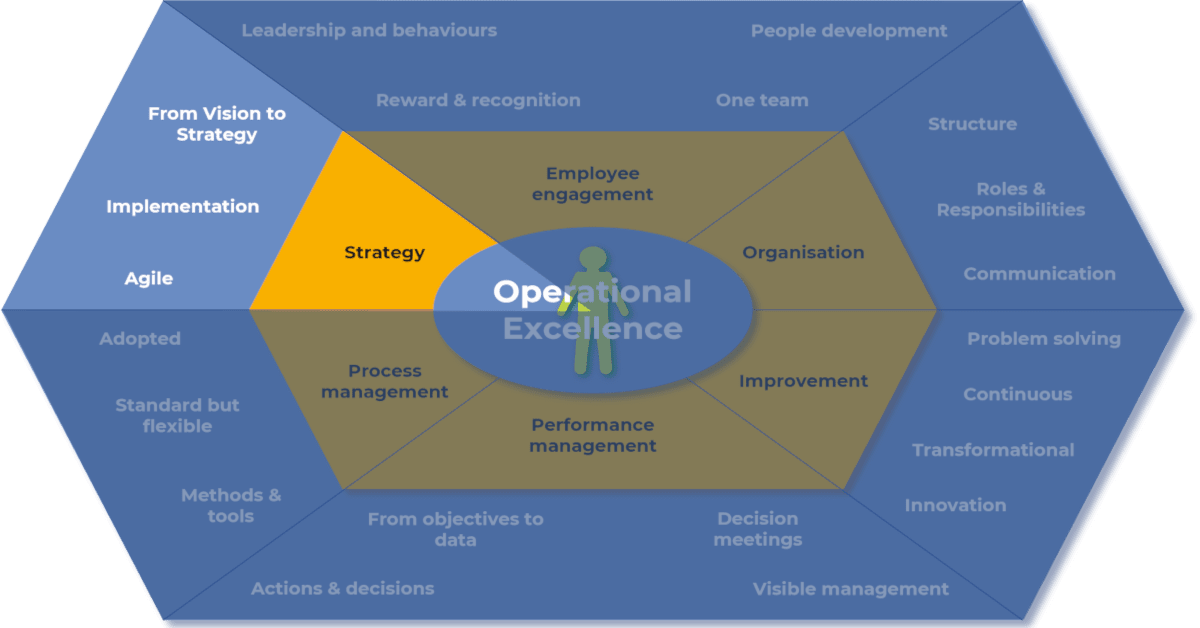
This page provides more information about the final pillar of our 100-criteria Operational Excellence model: Employee Engagement; with 17 criteria. Each item on this list is covered in more detail, but the goal of this document was never to provide you with a 100% overview of each one. Instead, we hope to provide a much-needed context - giving you enough details so that you can then use those criteria to evaluate your own organisation's Operational Excellence level in the future.

This page provides you with more information on all the 12 Organisation Design Excellence pillar criteria of our 100-criteria Operational Excellence model. Please note that the goal here was never to cover each item on this list in comprehensive detail. Instead, we simply want to give you more information about what each one means and what it represents. That way, you can use them to better evaluate your own company's Operational Excellence level in the future.

This page goes into greater detail of our practical 100 criteria Operational Excellence model, on the Improvement Excellence pillar, with 17 criteria numbered from 55 to 71. This page is not designed to explain at great length all the criteria described here. Instead, we simply want to give you enough details to understand them, allowing you to use them to evaluate your own organisation's Operational Excellence level moving forward.
This page describes the Process Excellence pillar of our 100-criteria Operational Excellence model. The principle of the Process Excellence pillar is to proactively manage processes so that they become the best possible and achieve excellence. The purpose of this page is to give you the main keys to evaluate your best process management and identify the ways to progress.
This page goes into greater detail of our practical 100 criteria Operational Excellence model, on the Performance Management pillar criteria, numbered from 19 to 54 after the criteria belonging to the Process management Excellence pillar (9 to 18). The goal is not to explain the entirety of all the criteria described here but to provide enough details so that one can use these criteria to evaluate his own Operational Excellence level using them.
This page details the Business Strategy Definition Pillar criteria of our Operational Excellence model. The goal is not to explain in great length all of the criteria described here, but to give you enough details to enable you to better evaluate your own definition and deployement of your strategy

Operational Excellence is essential because 67% of well-formulated strategies fail due to poor execution
In the modern business world, the importance of performing the right operational excellence assessment at exactly the right time in an organisation's life cannot be overstated enough. Oftentimes, these assessments come out of a need to obtain an in-depth, unbiased overview of a business' current capabilities. This usually comes about after managers identify certain operational issues that need to be addressed. Only by gaining the clearest possible picture of where you stand will you have a chance to identify what isn't working and, hopefully, what steps need to be taken to adequately correct those issues.
This page gives a few DILO Excel templates and PowerPoint templates. Each template is made to be used according to the DILO methodology and tools page and the DILO How -To practical guide page.
This page is a practical guide to perform a job or activity observation (also called DILO as "Day In the Life Of). It is a follow up of the Job Observation methodology and tools page describing what is a job observation, its objectives and the general methodology. The templates are in the Job Observation templates page.
Context: as a manager, you want to improve your organisation and you wonder whether you should start by an assessment of the current state
Defining performance indicators is unfortunately more important than defining the right objectives
"KPI" is one of the most searched word in the Business world with 163 000 searches / month according to Google Ads. There are thousands of sites giving you all the answers needed. However, some answers are difficult to find, others are inconsistent, and some topics are somewhat blurry or not really addressed.
Every manager's dream is to have effective meetings. That they are short, mobilising few people and enabling to take the right decisions or actions that will sustainably improve the performance of his organisation.





















